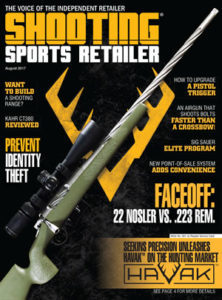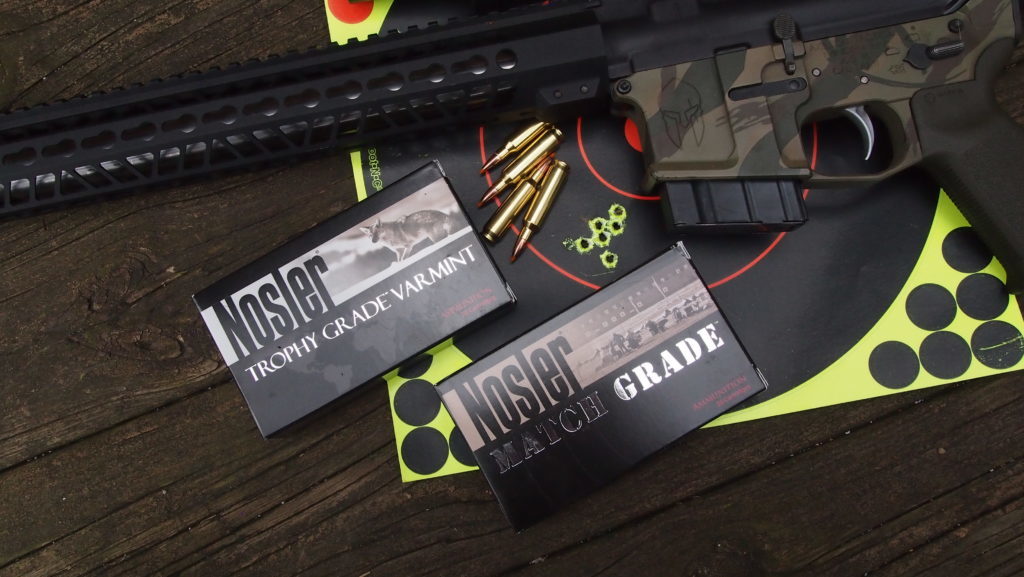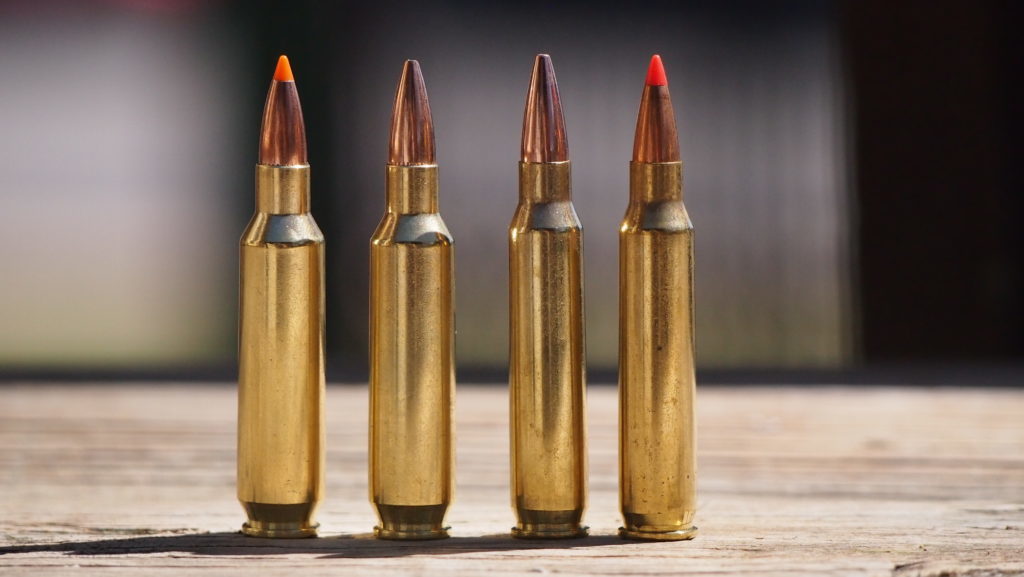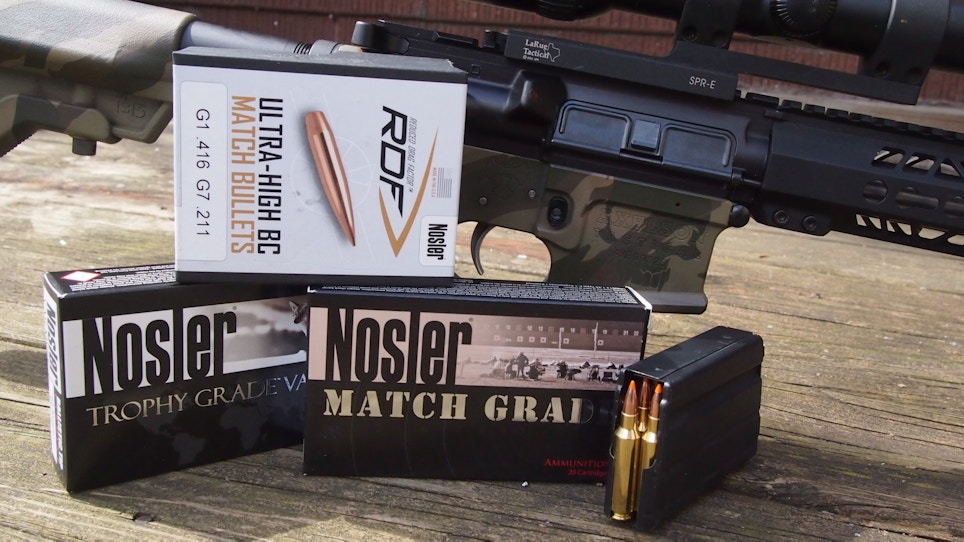In 1804, Lewis and Clark spotted their first coyote — or “prairie wolf,” as they dubbed it — in South Dakota at a time when the animals were unheard of beyond the Western states. In 2004, a coyote was seen in Washington, D.C., just miles from the White House. They’re eating their way across the country, and this isn’t by the thousands, it’s by millions. And coyotes’ single greatest enemy is indisputably the hunter. To help in this battle, Nosler is giving today’s coyote hunters an edge by arming them with something faster and harder-hitting — the 22 Nosler.
Background
Nosler is almost 70 years old and staffed by dedicated shooters and seasoned hunters. The company’s existence is thanks to founder John A. Nosler’s disgust with the poor performance of another manufacturer’s bullet during a moose hunt. Hunting is taken seriously by the Oregon-based ammunition manufacturer. That truth was brought to light with the creation of their latest cartridge.

From our August issue
“The AR-15 is indisputably one of the most popular firearms among shooting enthusiasts across the globe. While there are other hard-hitting cartridges that exist for the platform, as far as .22s are concerned, nothing compares to the performance of our newly engineered 22 Nosler case,” Nosler Executive Vice President John Nosler said. “It was important to us that every AR-15 owner could instantly customize their existing rifle to 22 Nosler without any fancy gunsmithing. In keeping with that goal, a simple switch of the magazine and upper will do the trick. With a cartridge innovation this significant, any shooter running other .22 cals in their AR-15, will at the very least, have to reconsider their efficiency.”
The 22 Nosler is the first cartridge of its kind for the company because its being made specifically for the AR platform. It technically does not have a parent case, but it can be aptly described as a slightly lengthened and necked-down 6.8 SPC. However, there are differences beyond those two measurements. The 22 Nosler is, as described by Nosler itself, the “most diminutive member of the Nosler cartridge family.” But that doesn’t mean it’s lacking in power. Even better, it means both hunters and sport shooters have a more powerful .22-caliber centerfire option for their existing AR-15s. Retrofitting a standard AR-15 chambered in .223/5.56 for the 22 Nosler chambering involves a simple swap of uppers and the use of a 6.8 SPC magazine. If you can field-strip your AR, you can change it over to the latest predator-hunting cartridge.
Technology And Ballistics
Ballistically speaking, there are a number of differences between the 22 Nosler and .223 Rem. First, from a technical standpoint, the 22 Nosler holds 34.2 grains H20 at overflow and 31.2 grains H20 with a 55-grain Ballistic Tip bullet seated to 2.260-inch OAL (overall cartridge length). The .223 Rem. holds 27.4 grains H20 with a 55-grain Ballistic Tip bullet seated to 2.260-inch OAL. This translates to 25 percent greater case capacity for Nosler’s newest cartridge over the older Remington cartridge. This, in turn, means there’s potential for advantages such as increased velocity.
The Sporting Arms and Ammunition Manufacturers Institute (SAAMI), which is the regulatory group tasked with collecting and publishing the industry standard for certified cartridges, is including the 22 Nosler as an approved cartridge. Data was collected using a 24-inch barrel with a 1:8 twist rate and a variety of powder types and charge weights. With 55-grain Ballistic Tip bullets, the most accurate powder tested was Varget. Varget delivers muzzle velocities of 3,092 and 3,406 fps at 87 percent and 93 percent load density, respectively. Handloaders interested in loading their own 22 Nosler rounds will be pleased to find SAAMI data readily available.
Testing And Accuracy
I used an upper from Nosler fitted to an Axelson Tactical multi-caliber AR-15 lower for testing. Since the 22 Nosler is being advertised as having multiple advantages over the .223/5.56 I also used an Axelson Tactical Black Pearl AR-15 chambered in .223 Wylde for comparison purposes. Both rifles had 18-inch barrels with 1:8 twist rates and each was topped with the new Trijicon Accupower scope for the duration of testing.

The 22 Nosler delivered fairly consistent 0.944-inch five-shot groups in the 55-grain Trophy Grade Varmint load while the 77-grain Match Grade load averaged 1.162-inch groups.
The marketing campaign from Nosler features the banner “easy as 1, 2, 3, 350 fps,” and a velocity gain of 300 fps over .223/5.56 is included in advertisements. Unsurprisingly, chronographing the 22 Nosler alongside both .223 Rem. and 5.56 NATO showed velocity is dependent upon not only bullet weight, but on the ammunition manufacturer. For example, a 55-grain 22 Nosler averaged 3,349 fps, resulting in a sizable gap of over 500 fps when compared to Hornady 55-grain FMJ at 2,829 fps. However, Hornady 53-grain Superformance Varmint V-MAX averaged 3,321 fps, closing the velocity gap to just 28 fps. (For complete ballistics results please refer to the included chart.)
Of course, there is more to testing than velocity alone. Accuracy matters in all situations, but for hunters its importance increases exponentially. A clean kill is the moral and ethical responsibility of every hunter and carrying it out requires an accurate, reliable gun and ammunition.
Loaded with the 55-grain Ballistic Tip rounds, the 22 Nosler delivered consistent sub-MOA five-shot groups. The best was a group of .809 inches. This is the load Nosler calls its Trophy Grade Varmint round, and with this kind of accuracy it will undoubtedly put fur on the ground. The heavier 77-grain Match Grade round resulted in an average five-shot group of 1.162 inches, which is still a solid group despite not being sub-MOA.
Comparatively, Axelson Tactical’s Black Pearl AR-15 loaded with Hornady .223 Rem. 53-grain Superformance Varmint V-MAX nailed a series of Shoot-N-C targets with tight five-shot groups, averaging .903 inches. Of course, as mentioned above, ammunition matters. Federal 5.56 NATO 55-grain FMJ produced five-shot groups averaging 1.37 inches.
The Bottom Line
Coyote hunting is gaining popularity not only among hunters, but among gun owners interested in trying their trigger fingers at hunting for the first time. All hunters need guns capable of exceeding their needs and expectations. So what does the ideal predator gun entail? Speed, accuracy, and reliability — for a start. The 22 Nosler offers all those things and more.

Left to right: Nosler’s 22 Nosler in Trophy Grade Varmint 55-grain Ballistic Tip and Match Grade 77-grain BTHP, Hornady .223 Rem. 75-grain BTHP Match and Hornady Superformance .223 Rem. 53-grain V-MAX.
The average gun owner may not own an AR with a high-quality barrel capable of delivering sub-MOA accuracy. The barrel on the Axelson Tactical comparison rifle was from Proof Research, a company known for quality and performance. The barrel on the average bargain-priced AR-15 simply does not live up to those high expectations. A complete rifle does not have to be purchased; a standard AR-15 can be retrofitted for 22 Nosler by switching out the upper, which takes only moments.
This is a cartridge likely to hold significant appeal for experienced coyote hunters interested in improved accuracy, coyote contest competitors looking to gain an edge over their competition and shooters simply wanting a quality rifle chambered in a new, interesting cartridge. Because it’s made for the AR-15 platform it taps into a vast market spanning endless aspects of the shooting sports, and thanks to Nosler’s promise to offer their M48 bolt-action rifle line in 22 Nosler in the future it will appeal to those who prefer bolts as well.
Complete rifles are currently available from Colt Competition, Noveske and Radian Weapons. Uppers and barrels are available from AR-Stoner AR-15, Columbia River Arms/Black Hole Weaponry and Odin Works. Proof Research and White Oak Armament are offering barrels only. Complete rounds and components are being manufactured by Nosler. After all, many predator hunters spend even more time at their reloading benches than behind their triggers, meaning 22 Nosler bullets might sell at an even higher rate than the rounds themselves.
Will the 22 Nosler become the favored round of predator hunters everywhere? Only time will tell, but given the round’s accuracy and the simplicity of changing an AR-15 to the new chambering, it’s within the realm of possibility. As the saying goes, may the odds be ever in your ammunition’s favor.






